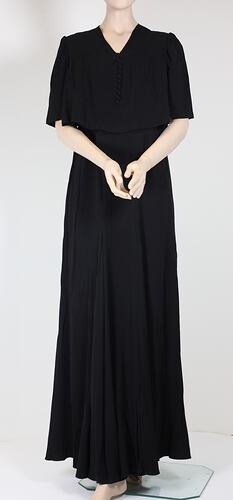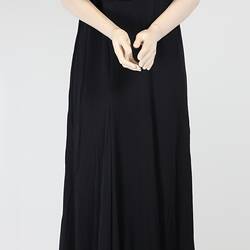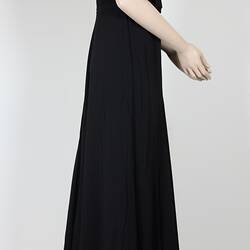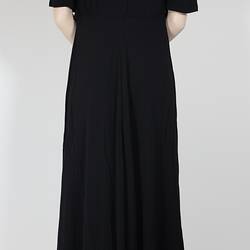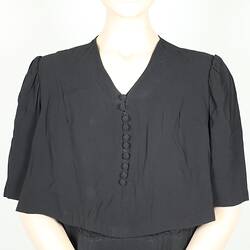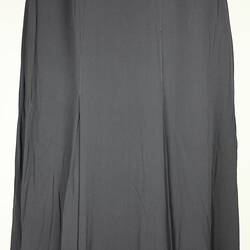Summary
Black silk crepe evening dress. Used circa 1920-1930. Belonged to Betty Anderson of Kew.
Betty (Elizabeth) was the daughter of James Caldwell Anderson and Mary Lloyd Anderson, and grand-daughter of renowned architect Lloyd Tayler. Born in 1889, Betty was one of four siblings, all of whom she outlived. The family lived at 'Mynda', 5 Molesworth Street, Kew, Melbourne. Betty seems to have served as a nurse during World War I, although details are confined to a nurse's apron and a photograph. She never married, and lived to the age of 92, passing away in 1982.
Betty (and her mother Minnie) had several items of black clothing in this period, which could suggest mourning clothing. Her father and brother had both died in 1915 (their deaths were not related to World War I). Although she was actively involved in World War I, serving with the Red Cross, Betty never married. It is not known if she lost others to whom she was close during the War.
Cann's was a department store in Swanston Street for much of the 20th century. An article in The Age, 19 February 1973 marked the changing of hands of Cann's, a family business established in 1909 by 40-year-old widow Hannan Cann, in a rented shop in Smith Street, Fitzroy. The article explained that she ran it with the help of her three daughters, and quickly expanded to three stores. In 1913 Cann's opened a shop on the site of the Capital Theatre in Swanston Street, and in 1920 Cann's moved to the corner of Swanston and Little Collins Streets. Hannah and her daughters remained closely involved in the daily activities of the business. Hannah retired in her seventies in 1935, when her daughter Nell took over; in 1965 Nell handed control onto her son Peter Tronson. Clothing appears to have remained the mainstay of the business.
Physical Description
Black satin-backed silk crepe evening dress. V-neck with false bolero front fastened with 10 self-covered buttons and loops. Bolero has shoulder darts at front. Its hem is finished with a black ribbon folded under and hand-stitched down. Two press studs are stitched to the inner front side of the bolero, seemingly to attach another component. Under the bolero is an under-bodice with a translucent v-neck yoke. The bodice has two bust darts coming from the yoke and two from the side seam. Set-in short sleeves gathered at shoulder, finished with a 20mm hem pressed and invisible stitched down. Skirt was originally machine-stitched to the bodice. It has a hand-stitched alteration to raise the waistline. Bias cut skirt falls from two stitched pleats into folds at front. Two small triangle inserts at hem line coming from the front seams. Centre back seam. Hem machine stitched into 0.5mm rolled hem.
More Information
-
Collecting Areas
-
Acquisition Information
Donation from Mrs Elizabeth Brodribb, 10 May 1989
-
User
Miss Elizabeth (Betty) T. Anderson, 5 Molesworth St, Kew, Greater Melbourne, Victoria, Australia, circa 1930
-
Retailer
-
Inscriptions
White and blue label on shoulder seam: 'Cann's / Swanston Street, Melbourne / London and Paris'.
-
Classification
-
Category
-
Discipline
-
Type of item
-
Overall Dimensions
1490 mm (Length)
Length from back of neck to hem. Measured on Mannequin.
-
Other Dimensions
360 mm (Width)
Width from shoulder seam to shoulder seam. Measured on Mannequin.
-
Other Dimensions
290 mm (Length)
sleeve length
-
Other Dimensions
3950 mm (Circumference)
Hem circumference
-
References
The Age, 19 February 1973, accessed via [Link 1] 21/6/2013
-
Keywords
Death & Mourning, Clothing, Fashion, Fashion Design, Women's Clothing, Dresses
